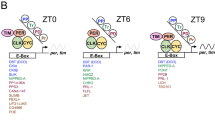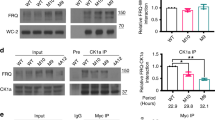Abstract
MUTATIONS in the period gene product (PER) can shorten or lengthen the circadian rhythms of Drosophila melanogaster1, but its biochemical activity has not been established. PER contains a motif of ∼2070 amino acids whose function is unknown (termed PAS2) and which is also present in three transcription factors of the basic–helix–loop–helix (bHLH) type, in the D. melanogaster single-minded gene product (SIM)2, and in both subunits of the mammalian dioxin receptor complex3,4,28. We show here that the PER PAS functions in vitro as a novel protein dimerization motif and that it can mediate associations between different members of the PAS protein family. The dimerization efficiency is decreased by several missense mutations in the PAS domain, including the original perL mutation, which lengthens circadian periods from 24 h to 29 h (ref. 1). The results indicate that the PAS domain may function as a dimerization domain in both SIM and the dioxin receptor complex, and that PER may regulate circadian gene transcription partly by interacting with the PAS domain of bHLH–PAS-containing transcription factors.
This is a preview of subscription content, access via your institution
Access options
Subscribe to this journal
Receive 51 print issues and online access
$199.00 per year
only $3.90 per issue
Buy this article
- Purchase on Springer Link
- Instant access to full article PDF
Prices may be subject to local taxes which are calculated during checkout
Similar content being viewed by others
References
Konopka, R. J. & Benzer, S. Proc. natn. Acad. Sci. U.S.A. 68, 2112–2116 (1971).
Nambu, J. R., Lewis, J. O., Wharton, K. A. & Crews, S. T. Cell 67, 1157–1167 (1991).
Hoffman, E. C. et al. Science 252, 954–958 (1991).
Burbach, K. M., Poland, A. & Bradfield, C. A. Proc. natn. Acad. Sci. U.S.A. 89, 8185–8189 (1992).
Baylies, M. K., Bargiello, T. A., Jackson, F. R. & Young, M. W. Nature 326, 390–392 (1987).
Hardin, P. E., Hall, J. C. & Rosbash, M. Nature 343, 536–540 (1990).
Hardin, P. E., Hall, J. C. & Rosbash, M. Proc. natn. Acad. Sci. U.S.A. 89, 11711–11715 (1992).
Liu, X. et al. J. Neurosci. 12, 2735–2744 (1992).
Rutila, J. E., Edery, I., Hall, J. C. & Rosbash, M. J. Neurogenet. 8, 101–113 (1992).
Zerr, D. M., Hall, J. C., Rosbash, M., & Siwicki, K. K. J. Neurosci. 10, 2749–2762 (1990).
Blackwood, E. M. & Eisenman, R. N. Science 251, 1211–1217 (1991).
Forman, B. M. & Samuels, H. H. Molec. Endocrin. 4, 1293–1301 (1990).
Fawell, S. E., Lees, J. A., White, R. & Parker, M. G. Cell 60, 953–962 (1990).
Smith, R. F. & Konopka, R. J. Molec. gen. Genet. 189, 30–36 (1982).
Benezra, R., Davis, R. L., Lockshorn, D., Turner, D. L. & Weintraub, H. Cell 61, 49–59 (1990).
Van Doren, M., Ellis, H. M. & Posakony, J. W. Development 113, 245–255 (1991).
Dunlap, J. C. & Feldman, J. F. Proc. natn. Acad. Sci. U.S.A. 85, 1096–1100 (1988).
Raju, U., Constantinos, K., Nuneu-Regueiro, M. & Eskin, A. Science 253, 673–675 (1991).
Rosbash, M. & Hall, J. C. Neuron 3, 387–398 (1989).
Dunlap, J. C. Trends Genet. 60, 159–165 (1990).
Khalsa, S. B. S., Whitmore, D. & Block, G. D. Proc. natn. Acad. Sci. U.S.A. 89, 10862–10866 (1992).
Citri, Y. et al. Nature 326, 42–47 (1987).
Kolodziej, P. A. & Young, R. A. Meth. Enzym. 194, 508–519 (1991).
Schindler, U., Menkens, A. E., Beckman, H., Ecker, J. R. & Cashmore, A. R. EMBO J. 11, 1261–1273 (1992).
Evan, G., Lewis, G., Ramsay, G. & Bishop, J. M. Molec. cell. Biol. 5, 3610–3616 (1985).
Liu, X., Lorenz, L. Yu, Q., Hall, J. C. & Rosbash, M. Genes Dev. 2, 228–238 (1988).
Zwiebel, L. J., Hardin, P. E., Liu, X., Hall, J. C. & Rosbash, M. Proc. natn. Acad. Sci. U.S.A. 88, 3882–3886 (1991).
Ema, M. et al. Biochem. biophys. Res. Commun. 184, 246–253 (1992).
Author information
Authors and Affiliations
Rights and permissions
About this article
Cite this article
Huang, Z., Edery, I. & Rosbash, M. PAS is a dimerization domain common to Drosophila Period and several transcription factors. Nature 364, 259–262 (1993). https://doi.org/10.1038/364259a0
Received:
Accepted:
Issue Date:
DOI: https://doi.org/10.1038/364259a0
This article is cited by
-
Differential impact on motility and biofilm dispersal of closely related phosphodiesterases in Pseudomonas aeruginosa
Scientific Reports (2020)
-
Circadian oscillator proteins across the kingdoms of life: structural aspects
BMC Biology (2019)
-
Cysteine residues are essential for dimerization of Hippo pathway components YAP2L and TAZ
Scientific Reports (2018)
-
Cardinal Epigenetic Role of non-coding Regulatory RNAs in Circadian Rhythm
Molecular Neurobiology (2018)
-
Agonist-mediated assembly of the crustacean methyl farnesoate receptor
Scientific Reports (2017)
Comments
By submitting a comment you agree to abide by our Terms and Community Guidelines. If you find something abusive or that does not comply with our terms or guidelines please flag it as inappropriate.



